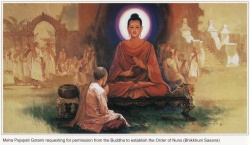Tri-svabhāva
Tri-Svabhāva (Skt.) The ‘three natures’—the dependent (Paratantra), the imagined (parikalpita) and the consummate (pariniṣpanna). A key Yogācāra theory first mentioned in the Sandhi-nirmocana Sūtra, the concept of the three natures serves to explain the
relationship between the experiences of Saṃsāra and Nirvāṇa. The theory may have arisen as a means to counter perceived shortcomings in the Madhyamaka theory of the Two Truths, which seems to create an unbridgeable hiatus between Enlightenment (Bodhi) and everyday
experience. According to the tri-Svabhāva theory, parikalpita corresponds to the mundane saṃvṛti-satya and pariniṣpanna to the supramundane paramārtha-satya, but the two are linked by Paratantra, the conditioned process of experience itself, which acts
as a common pivotal factor between those two. Though the three natures theory has sometimes been viewed as an ontological statement, it should more properly be understood as a model of the epistemological process—itself a major concern of the Yogācāra School.
See also grāhya-grāhaka.
